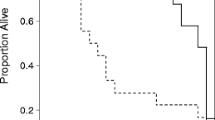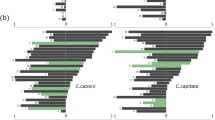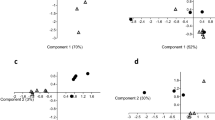Abstract
Non-random distribution patterns of specialized phytophagous insects on their hosts may depend on intraspecific differences in plant tissue quality, including nutrients and secondary compounds. Secondary compounds are involved in plant resistance, but are also important for the recognition and acceptability of plants as resources by specialized insects. If individuals within a plant species vary in their content of such secondary substances, there may also be qualitative differences between them. In such cases, natural selection will favor insects with the ability to distinguish and prefer the more suitable plants. In Sweden, the leaf beetle Gonioctena linnaeana Schrank (Coleoptera, Chrysomelidae) is highly specialized on one host, the native willow Salix triandra L (Salicaceae). Field observations reveal that some host plants in a population harbor many feeding larvae, causing severe defoliation, whereas neighboring plants may have few or no feeding larvae. Our hypothesis is that the distribution pattern of G. linnaeana larvae in this population results from qualitative differences between individual host plants in combination with the ability of G. linnaeana females to distinguish between plants that are suitable and not suitable for offspring performance. We examine whether larval survival differs depending on diet and whether the content of secondary chemical compounds explains female preference. Based on the higher survival rate of larvae reared on leaves from preferred hosts, we conclude that G. linnaeana females have evolved a behavior that maximizes offspring performance and thus positively affects female fitness. A chemical survey of the plants indicates that luteolin-7-glucoside and an unidentified flavonoid are important for separating the preferred from the non-preferred plants.



Similar content being viewed by others
References
Agrell J, McDonald EP, Lindroth RL (2000) Effects of CO2 and light on tree phytochemistry and insect performance. Oikos 88:259–272
Anderson SS, McCrea KD, Abrahamson WG, Hartzel LM (1989) Host genotype choice by the gallmaker Eurosta solidaginis (Diptera: Tephritidae). Ecology 70(4):1048–1054
Ayres MP, Clausen TP, MacLean SF Jr, Redman AM, Reichardt PB (1997) Diversity of structure and herbivore activity in condensed tannins. Ecology 78(6):1696–1712
Barrett RDH, Agrawal AA (2004) Interactive effects of genotype, environment, and ontogeny on resistance of cucumber (Cucumis sativus) to the generalist herbivore Spodoptera exigua. J Chem Ecol 30(1):37–51
Bernays EA (2001) Neural limitations in phytophagous insects: implications for diet breadth and evolution of host affiliation. Ann Rev Entomol 46:703–727
Coyle DR, McMillin JD, Hall RB, Hart ER (2003) Effects on cottonwood leaf beetle (Coleoptera:Chrysomelidae) larval defoliation, clone, and season on Populus foliar phagostimulants. Environ Entomol 32(3):452–462
Cronin JT, Abrahamson WG, Craig TP (2001) Temporal variation in host–plant preference and performance: constraints on host–plant adaptation. Oikos 93:312–320
Denno RF, Larsson S, Olmstead KL (1990) Role of enemy-free space and plant quality in host-plant selection by willow beetles. Ecology 71:124–137
Donaldson JR, Lindroth RL (2004) Cottonwood leaf beetle (Coleoptera: Chrysomelidae) performance in relation to variable phytochemistry in juvenile aspen (Populus tremuloides Michx.). Environ Entomol 33(5):1505–1511
Fujiyama N, Koizumi T, Katakura H (2003) Conspecific thistle plant selection by a herbivorous ladybird beetle, Epilachna pustulosa. Entomol Exp Appl 108:33–42
Hagerman A (1985) Tannin analysis. Department of Chemistry, Miami University, Ohio
Hallgren P, Ikonen A, Hjältén J, Roininen H (2003) Inheritance patterns of phenolics in F1, F2, and back-cross hybrids of willows: implications for herbivore responses to hybrid plants. J Chem Ecol 29(5):1143–1158
Hanks LM, Denno RF (1993) Natural enemies and plant water relations influence the distribution of an armoured scale insect. Ecology 74(4):1081–1091
Haukioja E, Neuvonen S (1985) Induced long-term resistance of birch foliage against defoliators: defensive or incidental? Ecology 66(4):1303–1308
Hemming JDC, Lindroth RL (1995) Intraspecific variation in aspen phytochemistry: effects on performance of gypsy moths and forest tent caterpillars. Oecologia 103:79–88
Horner JD, Abrahamson WG (1992) Influence of plant genotype and environment on oviposition preference and offspring survival in a gallmaking herbivore. Oecologia 90:323–332
Ikonen A, Tahvanainen J, Roininen H (2002) Phenolic secondary compounds as determinants of the host plant preferences of the leaf beetle, Agelastica alni. Chemoecology 12:125–131
Julkunen-Tiitto R (1985) Chemotaxonomical screening of phenolic glycosides in northern willow twigs by capillary gas chromatography. J Chromatogr 324:129–139
Julkunen-Tiitto R (1989) Distribution of certain phenolics in Salix species Salicaceae. PhD Thesis, University of Joensuu publications in Science, No. 15, Finland
Julkunen-Tiitto R, Sorsa S (2001) Testing the drying methods for willow flavonoids, tannins and salicylates. J Chem Ecol 27:779–789
Karban R (1987) Environmental conditions affecting the strength of induced resistance against mites in cotton. Oecologia 73(3):414–419
Keinänen M, Julkunen-Tiitto R, Rousi M, Tahvanainen J (1999) Taxonomic implications of phenolic variation in leaves of birch (Betula L.) species. Biochem Syst Ecol 27:243–254
Kelly MT, Curry JP (1991) The influence of phenolic compounds on the suitability of three Salix species as hosts for the willow beetle Phratora vulgatissima. Entomol Exp Appl 61:25–32
Koch K (1992) Die Käfer Mitteleuropas, Ökologie Band 3. Goecke andEvers Verlag, Krefeld
Kohlemainen J, Julkunen-Tiitto R, Tahvanainen J (1995) Phenolic glucosides as cues for willow-feeding leaf beetles. Entomoligia Experimentalis et Applicata 74:235–243
Kuokkanen K, Yan S, Niemelä P (2003) Effects of elevated CO2 and temperature on the leaf chemistry of birch Betula pendula (Roth) and the feeding behaviour of the weevil Phyllobius maculicornisK. Agric For Entomol 5:209–217
Leimu R, Riipi M, Staerk D (2005) Food preference and performance of the larvae of a specialist herbivore: variation among and within host–plant populations. Acta Oecologica 28:325–330
Matsuda K, Matsuo H (1985) A flavonoid, luteolin-7-glucoside, as well as salicin and populin, stimulating the feeding of leaf beetles attacking salicaceous plants. Appl Entomol Zool 20(3):305–313
Matsuki M, MacLean SF Jr (1994) Effects of different leaf traits on growth rates of insect herbivores on willows. Oecologia 100:141–152
Mattson WJ Jr (1980) Herbivory in relation to plant nitrogen content. Ann Rev Ecol Syst 11:119–161
McCrea KD, Abrahamson WG (1987) Variation in herbivore infestation: historical vs. genetic factors. Ecology 68:822–827
McCune B, Mefford MJ (1999) PC-ORD. Multivariate Analysis of Ecological Data. Version 4.25. MjM Software Design, Gleneden Beach, Oregon, USA
Mitter C, Farrell B, Futuyma DJ (1991) Phylogenetic studies of insect plant interactions–insights into the genesis of diversity. Trends Ecol Evol 6(9):290–293
Mopper S (1996) Adaptive genetic structure in phytophagous insect populations. Trends Ecol Evol 11:235–238
Niemi L, Wennström A, Ericson L (2005) Insect feeding preferences and plant phenolic glucosides in the system Gonioctena linnaeana–Salix triandra. Entomol Exp Appl 115:61–66
Orians CM, Griffiths ME, Roche BM, Fritz RS (2000) Phenolic glycosides and condensed tannins in Salix sericea, S. eriocephala and their F1 hybrids: not all hybrids are created equal. Biochem Syst Ecol 28:619–632
Rank NE (1992) Host plant preference based on salicylate chemistry in a willow leaf beetle (Chrysomela aeneicollis). Oecologia 90(1):95–101
Rank NE, Köpf A, Julkunen-Tiitto R, Tahvanainen J (1998) Host preference and larval performance of the salicylate-using leaf beetle Phratora vitellinae. Ecology 79(2):618–631
Regnault-Roger C, Ribodeau M, Hamraoui A, Bareau I, Blanchard P, Gil-Munoz M-I, Barberan FT (2004) Polyphenolic compounds of Mediterranean Lamiaceae and investigation of orientational effects on Acanthoscelides obtectus (Say). J Stored Prod Res 40(4):395–408
Renwick JAA (2001) Variable diets and changing taste in plant–insect relationships. J Chem Ecol 27:1063–1076
Rossi AM, Strong DR (1991) Effects of host-plant nitrogen on the preference and performance of laboratory populations of Carneocephala floridana (Homoptera: Cicadellidae). Ann Entomol Soc Am 20:1349–1355
Schoonhoven LM, Jermy T, van Loon JJA (1998) Insect–plant biology, from physiology to evolution. Chapman and Hall, London
Shonle I, Bergelson J (2000) Evolutionary ecology of the tropane alkaloids of Datura stramonium L. (Solanaceae). Evolution 54(3):778–788
Stenberg JA, Witzell J, Ericson L (2006) Tall herb herbivory resistance reflects historic exposure to leaf beetles in a boreal archipelago age-gradient. Oecologia 148:414–425
Tahvanainen J, Julkunen-Tiitto R, Kettunen J (1985) Phenolic glucosides govern the food selection pattern of willow feeding leaf beetles. Oecologia 67:52–56
Tahvanainen J, Julkunen-Tiitto R, Rousi M, Reichardt PB (1991) Chemical determinants of resistance in winter-dormant seedlings of European white birch (Betula pendula) to browsing by the mountain hare. Chemoecology 2:49–54
Thompson JN (1988) Evolutionary ecology of the relationship between oviposition preference and performance of offspring in phytophagous insects. Ent Exp Appl 47:3–14
Tikkanen O-P, Niemelä P, Keränen J (2000) Growth and development of a generalist insect herbivore, Operophtera brumata, on original and alternative host plants. Oecologia 122:529–536
Topp W, Kulfan J, Zach P, Nicolini F (2002) Beetle assemblages on willow trees: do phenolic glycosides matter? Divers Distrib 8:85–106
van der Meijden E (1996) Plant defense, an evolutionary dilemma: contrasting effects of (specialist and generalist) herbivores and natural enemies. Ent Exp Appl 80:307–310
Warchalowski A (2003) Chrysomelidae: the leaf-beetles of Europe and the Mediterranean area. Natura optima dux Foundation, Warszawa
Acknowledgments
A. Wennström was financially supported by FORMAS and The Lamm Foundation.
Author information
Authors and Affiliations
Corresponding author
Rights and permissions
About this article
Cite this article
Wennström, A., Niemi Hjulström, L., Hjältén, J. et al. Mother really knows best: host choice of adult phytophagous insect females reflects a within-host variation in suitability as larval food. Chemoecology 20, 35–42 (2010). https://doi.org/10.1007/s00049-010-0040-8
Received:
Accepted:
Published:
Issue Date:
DOI: https://doi.org/10.1007/s00049-010-0040-8




